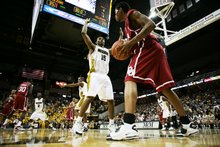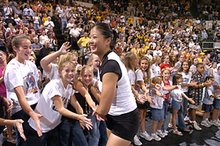Well, I have officially finished entering play-by-play information for Mizzou’s 2006 football games. I endeavor to get all Big XII teams entered by the end of the summer, but in the meantime I thought I’d start looking into what the data is telling me so far.
As I mentioned to Dave Matter earlier this week, one piece of information I’ve investigated is “successful” plays.
[T]he writers of Football Prospectus (http://www.footballoutsiders.com/) define a "successful play" as...As I entered play-by-play, I looked a few extra variables. Was the play a ‘success’ as defined above? What % of the first down did the play gain? What % of ‘success’ did the play gain? Et cetera. With this information, I thought it would be interesting to look at who the best “playmakers” were on the 2006 Mizzou squad.
- Gaining 40% of needed first down yardage on 1st down
- Gaining 70% of needed first down yardage on 2nd down
- Gaining 100% of needed first down yardage on 3rd or 4th down
This post will only look at defense.
For defense, a “successful play” would obviously be a play that prevented the offense from reaching the ‘success’ defined above. I also divided the plays into two categories: 1) plays when the score of the game was ‘close’ (i.e., the margin was somewhere between 0-15 points), and 2) plays when the score of the game was not close. I figure the best playmakers are the ones who earn their stats in closer games.
So what did I find? Well, as would be expected, using the standards above, defensive linemen are going to have a higher percentage of ‘successful’ plays simply because they start closer to the line of scrimmage than LB’s or DB’s. On the flipside, safeties are, by name, guys who are more likely to stop a big play than make a big play—and therefore, they’ll have the lowest percentage of ‘successful’ plays. The average Mizzou D-lineman had a ‘Successful Play to Non-Successful Play’ Ratio of 2.18. Defensive backs? 0.37. So if I’m trying to figure out a measure to use for any defensive player, I have to take their position into account. A defensive back with a 1.00 ratio is more effective than a defensive lineman with a 2.00 ratio. Makes sense, right?
So, for starters, I looked at what I’m tentatively calling the Position Playmakers Ratio. I’d call it the PPR, but giving it an acronym would make it seem like I’m sold on the name more than I actually am. I’m open to suggestion on the name.
What this ratio takes into account are two things: 1) the ‘Successful Play to Non-Successful Play’ Ratio (in ‘Close’ situations only...meaning, plays made when the score is within 15 points) mentioned above for a given player, and 2) the average Ratio for a player at that position. I basically just divide (1) by (2). If the ratio is above 1.0, then the player’s (1) is higher than the average player at their position. For now, I’ve only inputted Mizzou’s numbers, so (2) is only the average for Mizzou players. As I get more teams entered, (2) will change, and it will become an effective comparison of players from different teams.
So anyway, what are the PPR’s...I mean, Position Playmakers Ratios for last year’s Mizzou defensive players?
Lorenzo Williams – 1.95Those are the 8 players who were above 1.00, meaning they had a better (1) than the average at their position.
Dedrick Harrington – 1.56
Xzavie Jackson – 1.35
Darnell Terrell – 1.32
Pig Brown – 1.25
Brian Smith – 1.19
Stryker Sulak – 1.17
William Moore – 1.03
David Overstreet – 0.96Now, there are plenty of flaws in this measure. It doesn’t take into account Takeaways, which are obviously the most effective way of ‘playmaking’. If we figured out a way to take INT’s, forced fumbles and fumble recoveries into account (and I’ll get there eventually), Marcus Bacon (2 INT’s, 5 FF’s, 3 FR’s) would move way up the list, as would Lorenzo Williams (2 FF’s, 3 FR’s, plus 2 blocked kicks!) and Stryker Sulak (1 FF, 3 FR’s).
Marcus Bacon – 0.91
DeMarcus Scott – 0.79
Brandon Massey – 0.76
Jaron Baston – 0.75
Jamar Smith – 0.67
Ziggy Hood – 0.63 *
Hardy Ricks – 0.57
Brock Christopher – 0.53
Tommy Chavis – 0.51
Domonique Johnson – 0.45
* It’s worth noting that, in the first two games of the season, before he got hurt, 100% of Ziggy Hood’s tackles in ‘close’ games resulted in a success for the defense. Of course, there weren’t too many plays to make in ‘close’ situations against Ole Miss or Murray State since they became blowouts relatively quickly, but I think this does show that Hood was very obviously not the same player after his broken foot.
There is also another aspect to take into account regarding ‘playmaking’: in what percentage of your team’s plays are you involved? Success or no, close game or no, in what percentage of your team’s plays do you get a tackle or solo tackle? For this number, you’d expect LB’s to have a much higher % than DT’s or CB’s (you’d HOPE your CB’s aren’t too high), so let’s once again create a ratio out of the tackles a player made compared to what would be expected out of his position.
Taking injuries (and therefore fewer tackle opportunities) into account, here are the Top Ten Mizzou players in what we’ll call (for now) Tackles/Position Ratio (TPR?):
Darnell Terrell – 1.91You can tell pretty quickly that the players on this list were the ones who were likely on the field more—all these players started a good chunk of the season. So for now, this seems like as much a measure of tackle opportunities as it does anything else. However, considering how heavy the rotation was among the safeties—Overstreet, Massey, W. Moore, and Pig Brown—it is relatively impressive how high Overstreet’s ratio is here.
Xzavie Jackson – 1.59
David Overstreet – 1.55
Ziggy Hood – 1.47
Lorenzo Williams – 1.38
Brian Smith – 1.21
Marcus Bacon – 1.15
Stryker Sulak – 1.09
Brandon Massey – 1.06
Hardy Ricks – 1.06
And the fact that Terrell had that many more tackles than could be expected of the CB position is a bit confusing—did he have more tackles because the guy he was covering had more catches than they should have (he was, after all, almost always single-covering the opposition’s best WR), or because he was better in run support, or both?
For now, let’s say that having a high ‘Tackles/Position Ratio’ is a good thing (which is obviously debatable). What if we created one ‘playmaker measure’ by multiplying this TPR with the ‘PPR’ from above (what would we call it, the TPRPPR?)? The higher the number, the higher tackles and ‘successful plays’ than others at their position. Sounds like a great idea, right? Let’s see what that number tells us. Here are the top ten Mizzou players (bold = returning in 2007):
1. Lorenzo Williams – 2.69Lots of ground still to cover with these measures (and other ones I haven’t touched on yet), but I thought this would be something interesting to look at. The fact that Lorenzo Williams is that much higher than anybody else, I think, says something. What it says, exactly, will be more clear when I get other teams’ data entered. I bet you can’t wait.
2. Darnell Terrell – 2.51
3. Xzavie Jackson – 2.14
4. Dedrick Harrington – 1.63
5. David Overstreet – 1.50
6. Brian Smith – 1.43
7. Stryker Sulak – 1.28
8. Marcus Bacon – 1.04
9. Ziggy Hood – 0.93
10. William Moore – 0.90
As always, I open the floor here for feedback. Are there other things I should be looking at with this data?






|